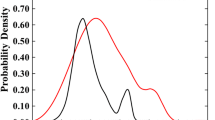Abstract
The microscopic response characteristics of nuclear magnetic resonance (NMR) are widely used for characterizing complex pore structures of rocks. Due to the prohibitive NMR experiment cost, numerical simulation was employed as an alternative approach to verify some theoretical aspects of NMR responses. Firstly, the basic principles of pore-scale NMR simulation based on random-walk method (RWM) were introduced. The RWM-simulated results were benchmarked with the analytical results for an ideal spherical pore model. Then, the effects of two numerical parameters, namely diffusion radius and walk numbers, were studied on the simulation accuracy. The simulation method is then applied to various pore models with different pore sizes and pore shapes filled with different fluids to study the microscopic NMR response characteristics. The numerical experiments are useful for understanding and interpreting NMR measurements and the simulation code provides a numerical tool to perform pixel-based digital rock analysis.
Similar content being viewed by others
References
COATES G R, XIAO Li-zhi, PRAMMER M G. NMR logging principle & applications [M]. Texas: Gulf Publishing Company, 1998: 12–13.
DUNN K J, BERGMAN D J, LATORRACA G A. Nuclear magnetic resonance: Petrophysical and logging applications [M]. Kidington: Elsevier Press, 2002: 8–9.
XIAO Li-zhi, XIE Ran-hong, LIAO Guang-zhi. NMR logging theories and methods of complex reservoir in China [M]. Beijing: Science Press, 2012. (in Chinese)
DUNN K J, LATORRACA G A, WARNER J L. On the calculation and interpretation of NMR relaxation SPE28367 [C]// 69th Annual SPE Technical Conference and Exhibition. New Orleans, 1994: 45–54.
SUN B Q, DUN K J. A global inversion method for multi-dimensional NMR logging [J]. J Magn Reson, 2005, 172(1): 152–172.
LIAO Guang-zhi, XIAO Li-zhi, XIE Ran-hong. Influence factors of multi-exponential inversion of NMR relaxation measurement in porous media [J]. Chinese J Geophys, 2007, 50(3): 932–938. (in Chinese)
GU Zhao-bin, LIU W. The inversion of two-dimensional NMR map [J]. Chinese Journal of Magnetic Resonance, 2007, 24(3): 311–319. (in Chinese)
TAN Mao-jin, SHI Yao-lin, ZHAO Wen-jie, YUN Hua-yun. Joint inversion method for NMR dual-TW logging data and fluid typing [J]. Chinese J Geophys, 2008, 51(5): 1582–1590. (in Chinese)
WANG Ke-wen, LI Ning. Numerical simulation on effects of reservoir characteristics and saturation on T2 spectra of nuclear magnetic resonance [J]. Acta Petrolei Sinica, 2009, 30(3): 423–426. (in Chinese)
COLES M E, HAZLETT R D, SPANNE P, SOLL W E, MUEGGE E L, JONES K W. Pore level imaging of fluid transport using synchrotron X-ray microtomography [J]. Journal of Petroleum Science and Engineering, 1998, 19(1): 55–63.
HIDAJAT I, SINGH M, COOPER J, MOHANTY K K. Permeability of porous media from simulated NMR response [J]. Transport in Porous Media, 2002, 48(2): 225–247.
ØREN P E, ANTONSEN F, RUESLÅTTEN H G, BAKKE S. Numerical simulations of NMR responses for improved interpretations of NMR measurements in reservoir rocks [C]// SPE 77398, SPE Annual Technical Conference and Exhibition. San Antonio, Texas, 2002.
ARNS C H, SHEPPARD A P, SOK R M, KNACKSTEDT M A. NMR petrophysical predictions on digitized core materials [C]// SPWLA 46th Annual Logging Symposium. New Orleans, Louisiana, USA, 2005.
VALFOUSKAYA A, ADLER P M, THOVERT J F, FLEURY M. Nuclear magnetic resonance diffusion with surface relaxation in porous media [J]. Journal of Colloid and Interface Science, 2006(295): 188–201.
TOUMELIN E, TORRES-VERDIN C, SUN B Q, DUNN K J. Random-walk technique for simulating NMR measurements and 2D NMR maps of porous media with relaxing and permeable boundaries [J]. Journal of Magnetic Resonance, 2007, 188(1): 83–96.
TOUMELIN E, TORRES-VERDÍN C, CHEN S. Modeling of multiple echo-time NMR measurements for complex pore geometries and multiphase saturations [J]. SPE Reservoir Evaluation & Engineering, 2003, 6(4): 234–243.
JIN G D, TORRES-VERDIN C, TOUMELIN E. Comparison of NMR simulations of porous media derived from analytical and voxelized representations [J]. Journal of Magnetic Resonance, 2009, 200(2): 313–320.
MOHNKE O, KLITZSCH N. Microscale simulations of NMR relaxation on in porous media considering internal field gradients [J]. Vadose Zone Journal, 2010, 9(4): 846–857.
CAI Shu-hui, CHEN Qiao-long, CAI Cong-bo. Monte Carlo simulation of liquid self-diffusion with surface relaxation [J]. Chinese Journal of Computational Physics, 2009 (1): 42–48. (in Chinese)
SENTURIA S D, ROBINSON J D. Nuclearspin-lattice relaxation of liquids confined in porous solid [J]. Society of Petroleum Engineering Journal, 1970, 10(3): 237–244.
ZHENG L H, CHIEW Y C. Computer simulation of diffusion controlled reactions in dispersions of spherical sinks [J]. Journal of Chemical Physics, 1989, 90(1): 32–327.
BUTLER J P, REEDS J A, DAWSON S V. Estimating solutions of first kind integral equations with nonnegative and optimal smoothing [J]. SIAM J Numer Anal, 1981, 18(3): 381–397.
WANG Wei-min, LI Pei, YE Zhao-hui. Multi-exponential inversion of NMR relaxation [J]. Science in China A, 2001, 31(8): 730–736. (in Chinese)
XIE Ran-hong, XIAO Li-zhi. Two-dimensional NMR logging method for identifying reservoir fluids [J]. Geophysics, 2009, 52(9): 2410–2418. (in Chinese)
TAN Mao-jin, ZOU You-long, ZHOU Can-can. A new inversion method for (T2, D) 2D NMR Logging and fluid typing [J]. Computer and Geosciences, 2013, 51(2): 366–380.
Author information
Authors and Affiliations
Corresponding author
Additional information
Foundation item: Project(265201248) supported by the Fundamental Research Funds for the Central Universities, China; Project(41172130) supported by the National Natural Science Foundation of China; Project(2011ZX05014-001) supported by the Major State S&T Special Fund, China; Project(201205002) supported by the China Scholarship Council; Project(2011D-5006-0305) supported by the China National Petroleum Co. Innovation Foundation, China
Rights and permissions
About this article
Cite this article
Tan, Mj., Xu, Jj., Zou, Yl. et al. Nuclear magnetic resonance (NMR) microscopic simulation based on random-walk: Theory and parameters analysis. J. Cent. South Univ. 21, 1091–1097 (2014). https://doi.org/10.1007/s11771-014-2041-1
Received:
Accepted:
Published:
Issue Date:
DOI: https://doi.org/10.1007/s11771-014-2041-1




